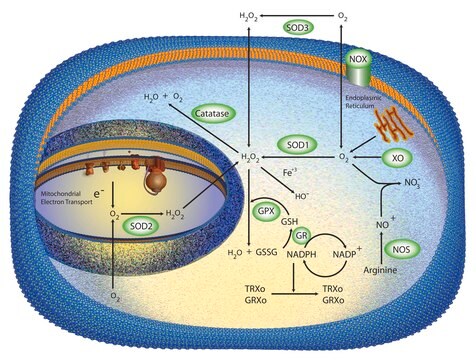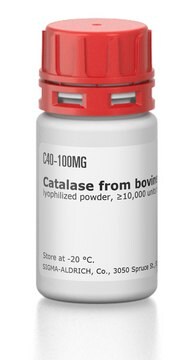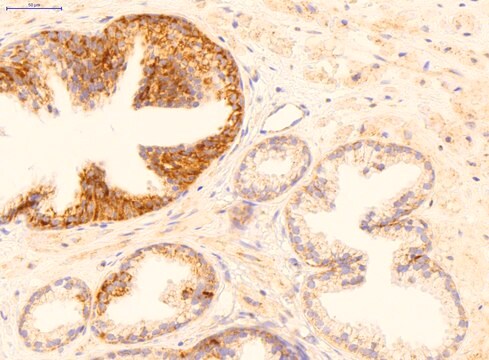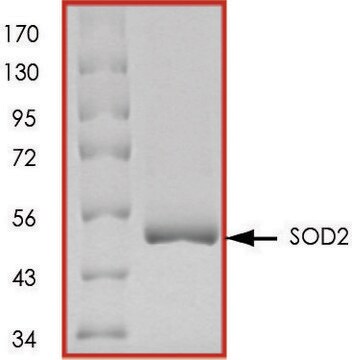S7571
Superóxido dismutasa from bovine erythrocytes
lyophilized powder, ≥3,000 units/mg protein, Protein ≥95 % by biuret
Sinónimos:
SOD, Superóxido: superóxido oxidorreductasa
About This Item
Productos recomendados
origen biológico
bovine
formulario
lyophilized powder
actividad específica
≥3,000 units/mg protein
mol peso
32.5 kDa
composición
Protein, ≥95% biuret
condiciones de almacenamiento
(Store under nitrogen.
Tightly closed. Dry.)
características de los productos alternativos más sostenibles
Atom Economy
Design for Energy Efficiency
Use of Renewable Feedstocks
Learn more about the Principles of Green Chemistry.
sustainability
Greener Alternative Product
técnicas
immunoblotting: suitable
inhibition assay: suitable
color
blue-green
pI
4.95
solubilidad
water: 20 mg/mL
aqueous buffer, pH 7.5: soluble
aplicaciones
diagnostic assay manufacturing
categoría alternativa más sostenible
temp. de almacenamiento
−20°C
Información sobre el gen
cow ... SOD1(281495) , SOD2(281496)
¿Está buscando productos similares? Visita Guía de comparación de productos
Categorías relacionadas
Descripción general
Superoxide dismutase (SOD) is a redox-active metalloenzyme expressed in both aerobic and anaerobic living organisms. Bovine superoxide dismutase or CuZn SOD is a homodimer with each subunit containing one zinc and one copper ion.
Aplicación
- in a study to assess a kinetic model of radiation-induced inactivation of superoxide dismutase in nitrous oxide-saturated solutions
- in a study to investigate the possible participation of superoxide anion in the intestinal tryptophan 2,3-dioxygenase reaction
- to investigate its effect on the hemolysis rate of human RBCs and hemoglobin-nitric oxide complex (HbNO) stability in human erythrocytes
- in combination with catalase to study its effect on cell differentiation in vitro
- to quantify superoxide levels and study their effect on reactivity in mouse pulmonary arteries through chemiluminescence and cytochrome C reduction methods
Acciones bioquímicas o fisiológicas
Definición de unidad
Forma física
Aplicación
Producto relacionado
Palabra de señalización
Danger
Frases de peligro
Consejos de prudencia
Clasificaciones de peligro
Resp. Sens. 1
Código de clase de almacenamiento
11 - Combustible Solids
Clase de riesgo para el agua (WGK)
WGK 1
Punto de inflamabilidad (°F)
Not applicable
Punto de inflamabilidad (°C)
Not applicable
Equipo de protección personal
Eyeshields, Gloves, type N95 (US)
Certificados de análisis (COA)
Busque Certificados de análisis (COA) introduciendo el número de lote del producto. Los números de lote se encuentran en la etiqueta del producto después de las palabras «Lot» o «Batch»
¿Ya tiene este producto?
Encuentre la documentación para los productos que ha comprado recientemente en la Biblioteca de documentos.
Los clientes también vieron
Artículos
Oxidative stress is mediated, in part, by reactive oxygen species produced by multiple cellular processes and controlled by cellular antioxidant mechanisms such as enzymatic scavengers or antioxidant modulators. Free radicals, such as reactive oxygen species, cause cellular damage via cellular.
Protocolos
Enzymatic Assay of Superoxide Dismutase
Separation of Superoxide dismutase
Chromatograms
application for HPLCNuestro equipo de científicos tiene experiencia en todas las áreas de investigación: Ciencias de la vida, Ciencia de los materiales, Síntesis química, Cromatografía, Analítica y muchas otras.
Póngase en contacto con el Servicio técnico











